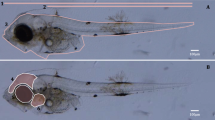Abstract
Two field experiments were conducted to assess the predictions of laboratory time-toxicity tests regarding lethal effects of triclopyr butoxyethyl ester (TBEE) on fish in standing and flowing water bodies. Large lake enclosures were treated with TBEE by backpack sprayer at concentrations of 0.25–7.6 mg/L, expressed as acid equivalents. Median dissipation times for TBEE in lake water ranged from 4–8 d.Effects of the treatments on survival and growth of caged rainbow trout were measured. All trout died by 3 d at initial concentrations of 0.69–7.6 mg/L. There was 43% mortality of rainbow trout in the enclosure treated at 0.45 mg/L, and no mortality in the 0.25 mg/L enclosure or the controls. The treatments at the two lower concentrations had significant adverse effects on the growth rates of surviving trout. TBEE was applied to sections of a forest headwater stream at nominal concentrations of 0.8 mg/L and 2.7 mg/L. These concentrations represent maximum-expected environmental concentrations in 50- and 15-cm deep bodies of water, respectively, when directly oversprayed at an application rate of 3.84 kg/ha. Concentrations of TBEE were rapidly dissipated (as much as 70% decline within 55 m) and exposure periods at concentrations above 0.1 mg/L varied from 25 min in the low-concentration area to 55 min in the high-concentration area. The applications of TBEE at both initial test concentrations did not result in any mortality of resident brook trout. There were no significant effects of the herbicide treatments on the growth of 1+ and 2+ brook trout, but there were indications that the growth of 0+ trout was reduced as a result of exposure to TBEE in the stream. These results were in general agreement with the predictions of laboratory time-toxicity tests.
Similar content being viewed by others
References
Bagenal TB, Tesch FW (1978) Age and growth. In: Bagenal TB (ed) Methods for assessment of fish production in fresh waters. IBP Handbook No. 3, 3rd Ed. Blackwell Scientific Publications, Oxford, pp 101–136
Barron MG, Mayes MA, Murphy PG, Nolan RJ (1990) Parmacokinetics and metabolism of triclopyr butoxyethyl ester in coho salmon. Aquatic Toxicol 16:19–32
Carle FL, Strub MR (1978) A new method for estimating population size from removal data. Biometrics 34:621–630
Fontaine DD (1990) Dispersal and degradation of triclopyr within a Canadian boreal forest ecosystem following an aerial application of Garlon® 4. Report GH-C 2314, Dow Elanco, Midland, MI
Johansen JA, Geen GH (1990) Sublethal and acute toxicity of the ethylene glycol butyl ether ester formulation of triclopyr to juvenile coho salmon (Oncorhynchus kisutch). Arch Environ Contam Toxicol 19:610–616
Kreutzweiser DP, Holmes SB, Behmer DJ (1992) Effects of the herbicides hexazinone and triclopyr ester on aquatic insects. Ecotoxicol Environ Safety 23:364–374
Kreutzweiser DP, Holmes SB, Eichenberg DC (1994) Influence of exposure duration on the toxicity of triclopyr ester to fish and aquatic insects. Arch Environ Contam Toxicol 26:124–129
McCall PJ, Laskowski DA, Bidlack HD (1988) Simulation of the aquatic fate of triclopyr butoxyethl ester and its predicted effects on coho salmon. Environ Toxicol Chem 7:517–527
Muirhead-Thomson RC (1987) Pesticide impact on stream fauna with special reference to macroinvertebrates. Cambridge University Press, Cambridge, UK
Sandheinrich MB, Atchison GJ (1990) Sublethal toxicant effects on fish foraging behavior: emperical vs. mechanistic approaches. Environ Toxicol Chem 9:107–119
Servizi JA, Gordon RW, Martens DW (1987) Acute toxicity of Garlon® 4 and Roundup® herbicides to salmon, Daphnia, and trout. Bull Environ Contam Toxicol 39:15–22
Solomon KR, Bowhey CS, Liber K, Stephenson GR (1988) Persistence of hexazinone (Velpar®), triclopyr (Garlon®) and 2,4-D in a northern Ontario aquatic environment. J Agric Food Chem 36:1314–1318
Thompson DG, Stanznik B, Fontaine DD, MacKay T, Oliver GR, Troth J (1991) Fate of triclopyr ester (Release) in a boreal forest stream. Environ Toxicol Chem 10:610–6232
U.S. Department of Agriculture (USDA) (1984) Pesticides background statement, Vol. 1: Herbicides Agriculture Handbook No. 633. USDA Forest Service, Washington, DC
Wan MT, Moul DJ, Watts RG (1987) Acute toxicity to juvenile Pacific salmonids of Garlon® 3A, Garlon® 4, triclopyr, triclopyr ester, and their transformation products: 3,5,6-trichloro-2-pyridinol and 2-methoxy-3,5,6-tricholorpyridine. Bull Environ Contam Toxicol 39:721–728
Author information
Authors and Affiliations
Rights and permissions
About this article
Cite this article
Kreutzweiser, D.P., Thompson, D.G., Capell, S.S. et al. Field evaluation of triclopyr ester toxicity to fish. Arch. Environ. Contam. Toxicol. 28, 18–26 (1995). https://doi.org/10.1007/BF00213964
Received:
Revised:
Issue Date:
DOI: https://doi.org/10.1007/BF00213964




